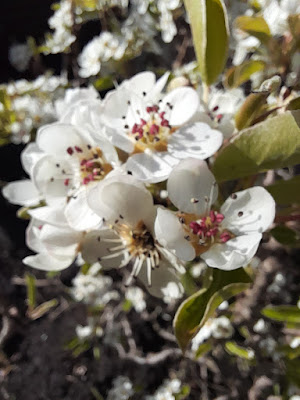Well, another year ticked off the calendar! And, despite many online casting doom around instead of joy, we've had a lot of reasons to enjoy this year!
In January, as well a three Great White Egrets at Lin Dyke at Fairburn Ings one day, we saw another interesting sight on another day a cycle ride to Wetherby. If any reader recalls watching Bagpuss, one will be familiar with the story involving the Old Man's Beard! For the first time, we saw it for real!
Clematis vitalba, like many clematis, is a climbing plant which flowers in August and September but the seed heads then go on to form the beard-like structure that gives rise to the name.
In February, another trip to Lin Dyke at Fairburn, which is a path overlooking the often flooded grazing meadows and lakes. The whole area used to be coal mining but you wouldn't know nowadays.
These Highland Cattle are left to roam in the service of the RSPB by an organic farm not very far away from the site.
Roe Deer are a regular sight around the area where I live, though this has been the biggest group I've seen of late (2 or 3 off camera too). These were in a field next to A64 road and I do wonder how many people travelling along actually saw them!
The old Roman road from York to Tadcaster is a good place to see wildflowers during Spring and Summer. These Lesser Celandines and Bluebells carpeted the ground in large numbers in April. West of Bilbrough Top is a good area to see a number of different, albeit common, butterflies and there's a good selection of bird species, especially the local Red Kites, to see.
As many people know, Mayflies don't appear for long! So, by the River Wharfe, downstream of Tadcaster, it was lovely to see quite of number of them and these are a family that I've not really seen close up much before, normally they are out over rivers or dykes and not easily observable close up.
This one is the Green Drake mayfly (Ephemera danica)
In June, well, I could fill pages of blogs with our photos from our herpetogy focused tour led by Prof. Stephen Mullin and assisted by Jessica Yates in the rainforests of Panama but for now, I'll show you one of the recently described species that we saw there. This is Sylvia's Tree Frog, described in 2018 by Andrew Gray, Curator of Herpetology at Manchester Museum. This species, that occurs in Panama and nortern Columbia was once thought to be a variant of the Splendid Tree Frog, but was proved to be genetically distinct. To see so many creatures up close was such a privilege!
One of our many wildlife interests is in Dragonflies and Damselflies. YWT Askham Bog in July is a very good time to see several different species including this Ruddy Darter (Sympetrum sanguineum)
Another place we go sometimes is YWT Hetchell Wood, a large area of woodland, partly an old quarry, near Thorner, east of Leeds. There's plenty of different wildflowers and mosses to see here and some great views from the escarpment. Though a walk is sometime spoilt here by dogs running off lead out of sight of their owners, like at so many nature reserves nowadays.
In August we took another walk there to see wildflowers and insects. This is a Hornet Mimic Hoverfly (Volucella zonaria) and it is easy to see why from the markings. Again, another insect I've not noticed before but once you see one, they are relatively common in the right habitat.
.jpg)
The Hazel tree in the allotment has been incredibly productive this year, and the nuts have lasted us until Christmas! In February, it will need coppicing and pruning, it looks worse than it is as hazel is a very fast growing wood and this activity will stimulate growth. I've started putting a large sheet of crop protector down underneath the tree to make it easy to find the nuts, though they do seem to spread over quite an area in the allotment!
Every year we grow some sunflowers in the allotment, though some do self seed. They are a magnet for bees and other insects, like this carder bee. These flowered quite late this year and were at their best in October.
The very small things in nature fascinate me. Whether that's insects or flowers or in this case, lichen and mosses. Getting close up with lichens and mosses and liverworts is like entering a miniture world with tiny forests and strange formations. Identification though, well that's another matter but the main lichen in this picture I believe to be Xanthoria parietina. This was on a gate near Bolton Percy in November.
Ok, a little bit of cheating! The weather has been very poor in December 2023 for getting out into nature, so here's a photo from December 2022, again at Lin Dyke, Fairburn Ings, of a group of Whooper Swans that migrate to the UK for winter, often from Iceland. The main way to tell them apart from the resident Mute Swans is the beak colour and markings, with the Whooper Swan having a beak much more yellow in colour.








.jpg)

.jpg)

























